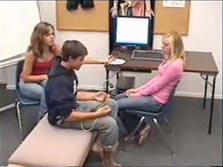S04 ECG 2

ECG 2 explains Einthoven’s triangle. Students record Leads I and III while performing a number of tasks designed to change the rhythm of the heart. They then analyze the data and estimate the mean QRS axis and potential.
Experimental Objectives
-
To record ECG from Leads I and III in the following conditions: lying down, sitting up, and breathing deeply while sitting.
-
To compare the direction of the QRS complex (+ or -) with the direction of the lead axis.
-
To estimate the mean ventricular potential.
-
To estimate the mean electrical axis of the QRS complex.
Tasks Performed by the Student
-
Record ECG using bipolar Leads I and III.
-
Lie down and relax.
-
Sit and relax.
-
Breathe in and out once in each position.
Videos
Biopac Student Lab Student Download
Student Prep & Distance Learning
Click the link(s) below for sample data and/or lesson procedure video(s), BSL PRO Lesson procedures (PDF) for human lessons*, and graph template files (*.gtl) for BSL PRO Lessons. If more than one .gtl is available, download the .gtl with the _suffix to match BSL version and hardware.
WHAT'S NEW
Speech and communication are integral parts of human relationships and development As such,...
Stay Connected